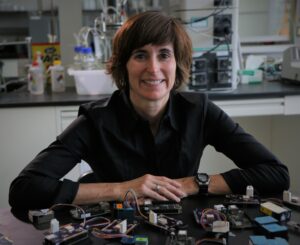
During the smoky summer of 2018, two wildfires in Utah County burned a combined 121,000 acres, sending smoke pouring into the valleys of the Wasatch Front. Atmospheric scientists are always working to better forecast how smoke moves from fires, just as they work to forecast hurricanes and snowstorms.
But the fires in 2018 provided a unique opportunity for scientists. Across the Wasatch Front, both researchers and community members maintain enough air quality sensors to provide a high-resolution picture of how the smoke moved through the valley—perfect for testing and refining smoke forecast models.
“This forecast would be similar to how we would forecast rainy weather or clear conditions,” says Derek Mallia, research assistant professor in the Department of Atmospheric Sciences, “except we can now do it for smoke.”
Mallia and his colleagues, including researchers from the Department of Chemical Engineering and School of Computing, published their results in the Journal of Geophysical Research-Atmospheres. The study, which was co-authored by chemical engineering assistant professor Kerry E. Kelly, School of Computing professor Ross Whitaker and electrical and computer engineering associate professor Pierre-Emmanuel Gaillardon, involved the use of their air quality sensor network that is deployed throughout Utah’s Wasatch Front.
An air quality network
Air quality is a high-priority topic for Utahns. Because of the Salt Lake Valley’s mountainous geography, the area experiences wintertime temperature inversions that trap air pollution and emissions, often resulting in unhealthy air conditions. Researchers, particularly those at the U, have focused on understanding and measuring the air conditions in the valley through a network of research-grade sensors. They’ve also placed sensors on vehicles that move through the valley: TRAX light rail, Google StreetView cars and a van affectionately named the “NerdMobile.”
Members of the community also maintain their own sensors. Kelly and her colleagues have developed low-cost interconnected particulate matter sensors that are maintained by homeowners throughout the Salt Lake Valley, improving the resolution of measurements. The low-cost sensor network is called Air Quality and U, or AQ&U. Air pollution is not distributed evenly, and all of these sensors together help researchers understand the where, when and why of polluted air. The portable sensors were designed by Kelly, U chemical engineering associate professor (lecturer) Tony Butterfield and Gaillardon and are connected to a network that was developed with the help of Whitaker.
Modeling smoke
In Utah’s summers, however, a temperature inversion isn’t a problem. But smoke from Western wildfires is.
“From a practical standpoint, smoke is yet another variable that we need to account for in a weather forecast,” Mallia says. “Similar to how unsettled weather such as snow or thunderstorms can impact our everyday activities, smoke can also play an important role.” Particularly vulnerable, he says, are people with asthma or other respiratory or cardiovascular diseases. Smoke can also impact recreation. “Who wants to go sightseeing when Utah is blanketed in smoke?”
Models that predict the movement of smoke need to be validated, or compared with observations, to make sure they’re simulating smoke conditions with reasonable accuracy. But when wildfires occur in remote locations, the limited number of air quality sensors is usually not sufficient to evaluate models. That’s where the Salt Lake Valley’s air quality network comes in.
What the network saw
In the 2018 fire season, nearly 60,000 fires burned nearly 9 million acres, including more than 18,000 homes, across the United States. Following months of hot and dry conditions, the Pole Creek and Bald Mountain Fires combined to burn nearly 121,000 acres in central Utah. The smoke-filled the valleys of the Wasatch Front, which were fortunately well-equipped with air quality instrumentation. When the fires were safely contained, the researchers saw a scientific opportunity.
Mallia, Kelly, U research assistant professor Logan Mitchell and colleagues including professor Adam Kochanski of San Jose State University and professor Jan Mandel of CU Denver, looked at the data that came back from the sensors—both the research-grade sensors and the low-cost versions at people’s homes. Their results showed that measurements of particulate matter in the air by the low-cost sensors were accurate to within 10% of the measurements at nearby research-grade sensors.
Smoke forecasts from the model captured the timing of smoke arrival, but not the amount—the researchers found that the forecast overestimated the amount of smoke by a factor of two. That result helps the scientists to then go back to the model and figure out why so that the next version can be more accurate.
The results also gave some insights into how the mountain valleys can disperse the smoke. “For example,” Mallia says, “we found that canyon winds during the nighttime can filter cleaner mountain air into the valley, which is why we saw less polluted air near the valley benches.”
The value of the community
Mallia says that the sensors on TRAX trains were invaluable in covering more ground than a stationary air monitor, and that the involvement of community members, with sensors around their homes, was key to expanding the study area even further.
“There is a lot of space in the valley that is privately owned, so getting the public involved is the only way that we can properly sample different areas across the Salt Lake Valley,” he says. “This allows us to sample more points in the valley and gives us greater confidence towards identifying the strengths and weaknesses of our smoke forecasts.”
Unfortunately, he adds, smoky days will become more frequent in the future. Climate change is projected to make hot and dry conditions more likely, which is the perfect recipe for more numerous and intense wildfires. Forecasts can’t prevent the smoke from coming any more than weather forecasts can prevent blizzards or hurricanes—but they can help all of us stay informed and prepared.
Find the full study here.